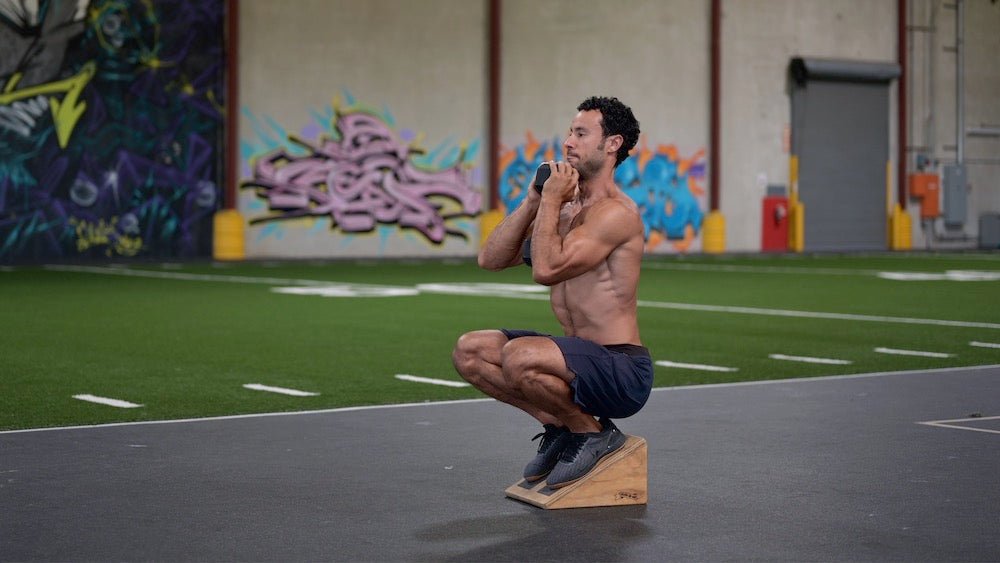Are you tired of the same old leg day routine? Ready to spice things up and elevate your fitness game?
Well, you're in for a treat.
Today, we're going to talk about the heels-elevated goblet squats, a powerful exercise that's about to become your new best friend at the gym.
Picture this: You, confidently holding a dumbbell like it's a chalice of strength, conquering gravity one squat at a time.
The elevated goblet squat isn't just any ordinary exercise; it's a game-changer that will leave your quads trembling, your core engaged, and your confidence soaring.
So, let's not waste any more time - it's time to learn how to perform this exercise with finesse and reap the incredible benefits it has to offer:
What Is A Heel-Elevated Goblet Squat?

The heels-elevated goblet squat is a variation of the traditional goblet squat that involves lifting your heels off the ground by placing them on a small platform or weight plates.
This exercise can help improve ankle mobility, increase the range of motion in your squat, and target your quadriceps to a greater extent.
How To Perform The Heel-Elevated Goblet Squat?

Here's how to perform the heels-elevated goblet squat:
Equipment You'll Need:
- Dumbbell or kettlebell (for the goblet position)
- A stable platform or weight plates to elevate your heels (optional)
Step-By-Step Guide
- Set up your equipment: Place a stable platform or weight plates under your heels. You can use something about 1-2 inches high. Ensure that the surface is stable and can support your weight.
- Select the weight: Choose an appropriate dumbbell or kettlebell weight for your fitness level. Beginners may start with a lighter weight, while more advanced individuals can go heavier.
- Proper body positioning: Stand with your feet shoulder-width apart or slightly wider. Your toes should be pointing slightly outward. Hold the dumbbell or kettlebell close to your chest with both hands, keeping your elbows tucked in.
- Elevate your heels: Position your heels on the elevated surface so that your toes are on the ground, and your heels are lifted. This is the key feature of the heels-elevated squat.
- Initiate the squat: Begin the squat by pushing your hips back and bending your knees. Keep your chest up, back straight, and core engaged throughout the movement. The elevated heels will allow you to lean forward slightly without losing balance.
- Descend: Lower your body down into a squat position, ensuring that your knees are tracking in line with your toes. Go as low as your mobility allows while maintaining good form. Ideally, try to get your thighs parallel to the ground or lower.
- Ascend: Push through your heels and drive your hips forward to stand back up. Keep your core tight and maintain the elevated heel position throughout the movement.
- Complete the repetition: Return to the starting position, standing upright with the dumbbell or kettlebell close to your chest. This completes one repetition.
- Perform the desired number of reps: Depending on your fitness goals and ability, perform 3-4 sets of 8-12 repetitions.
What Are The Benefits Of Heel-Elevated Goblet Squat?

Listed below are some of the advantages of heel elevated goblet squat:
1. Increased Ankle Mobility
Elevating the heels in this squat variation can help improve ankle flexibility and mobility. This is particularly beneficial if you have limited ankle mobility, which can restrict your ability to perform deep squats with proper form.
2. Enhanced Quadriceps Activation
The heels-elevated position shifts more of the emphasis onto the quadriceps (front thigh muscles). This can be useful if you want to target and develop your quadriceps specifically.
3. Core Activation
Just like with traditional squats, the goblet squat requires you to engage your core to stabilize your spine and maintain proper posture. This exercise can help strengthen your core muscles.
4. Variation and Muscle Confusion
Incorporating different squat variations, such as the heel-elevated goblet squat, into your workout routine can prevent plateaus and keep your workouts interesting. It also allows you to target your muscles from different angles.
5. Functional Strength
This exercise can translate well to everyday activities that require squatting, such as picking up objects from the ground. The improved ankle mobility and balance can be especially useful in real-life scenarios.
6. Engagement of Glutes
While the emphasis is on the quadriceps, the heels-elevated goblet squat still involves the glutes, which play a crucial role in hip extension and overall lower body strength.
Common Heels-Elevated Goblet Squat Mistakes

Performing the heels-elevated goblet squat correctly is crucial to avoid injury and maximize the benefits of the exercise.
Here are some common mistakes to watch out for:
· Lack of Proper Heel Elevation
Using an unstable or uneven surface to elevate your heels can lead to balance issues and increase the risk of injury. Make sure the surface you use is stable and provides a consistent height for both heels.
· Leaning Too Far Forward
While the elevated heels allow for a slight forward lean, excessive leaning can put strain on your lower back and compromise your form. Maintain an upright chest and back position throughout the movement.
· Knees Collapsing Inward
Allowing your knees to collapse inward as you squat can put unnecessary stress on your knees and increase the risk of injury. Focus on keeping your knees in line with your toes.
· Using Too Much Weight
Starting with excessive weight can compromise your form and lead to poor squatting mechanics. Begin with a manageable weight that allows you to perform the exercise with proper technique.
· Neglecting Ankle Mobility
While the exercise can help improve ankle mobility, it's essential to have a baseline level of mobility to perform it safely. If you have severe ankle mobility limitations, consider addressing them with mobility exercises before attempting this squat variation.
Heels-Elevated Goblet Squat Variations
Variations of the heels-elevated goblet squat can add variety to your workout routine and target different muscle groups.
Here are some variations you can try:
Single-Leg Heels-Elevated Goblet Squat
- Elevate one heel while keeping the other foot off the ground.
- Perform squats with a dumbbell or kettlebell while balancing on one leg.
- This variation enhances balance and works on each leg independently.
Pulse Heels-Elevated Goblet Squat
- Perform a regular heels-elevated goblet squat.
- After reaching the lowest point of the squat, pulse up and down slightly before ascending to the starting position.
- This variation adds an extra challenge and increases time under tension.
Sumo Heels-Elevated Goblet Squat
- Take a wider stance with your toes pointing outwards.
- Elevate your heels and perform goblet squats in this sumo stance.
- This variation places more emphasis on the inner thighs and glutes.
Elevated Heels Pistol Squat
- Elevate both heels and stand on a stable surface.
- Perform a pistol squat by extending one leg in front of you while keeping the other elevated heel on the platform.
- Pistol squats are highly challenging and require significant strength and balance.
Pause Reps Heels-Elevated Goblet Squat
- Perform the heels-elevated goblet squat as usual, but pause for 2-3 seconds at the lowest point of the squat.
- This variation increases the time under tension, enhancing muscle engagement and endurance.
Tempo Heels-Elevated Goblet Squat
- Control the tempo of your squat by slowing down the eccentric (lowering) phase and the concentric (lifting) phase.
- For example, take 4 seconds to lower yourself, hold for 2 seconds at the bottom, and then take 2 seconds to stand up.
- This variation builds muscle control and endurance.
Weighted Heels-Elevated Goblet Squat
- Perform the heels-elevated goblet squat while holding a heavier dumbbell or kettlebell.
- This adds more resistance to the exercise, increasing strength gains.
Heels-Elevated Goblet Squat Jumps
- Begin with a heels-elevated goblet squat.
- Instead of returning to the standing position, explode upward into a jump.
- Land softly and immediately transition into the next squat.
- This variation adds plyometric elements to the exercise, boosting power and explosiveness.
Banded Heels-Elevated Goblet Squat
- Secure resistance bands around your knees or thighs.
- Perform the heels-elevated goblet squat while actively pushing against the bands.
- This variation increases the activation of your hip abductors and adds resistance throughout the squat.
Final Remarks
The elevated goblet squat is your ticket to stronger legs, a firmer core, and a more resilient body.
It's a simple yet potent exercise that you can easily incorporate into your fitness routine, whether you're a seasoned gym-goer or just starting your fitness journey.
So, don't be shy – grab your dumbbell, find a sturdy surface to elevate yourself, and get ready to squat your way to greatness.



